#NaturallyGabakins
Text



🐕🐩🦮🐕🦺🐕🐩🦮🐕🦺🐕🐩🦮🐕🦺🐕🐩🦮🐈
Day 14.
Today I researched the Morkie.
It is sometimes called the Yorktese or Morkshire terrier and has inherited many great qualities from its parent breeds (Maltese + Yorkshire Terrier) and has some other quirks that make it unique.
One thing you can pretty much always expect in a Morkie is a long and luxurious coat of hair since that’s a predominant feature in both parent breeds. You can’t be as sure about the color of the coat, however. It may be black and tan like the Yorkshire terrier, white like that of the Maltese, or somewhere in between. My Morkie is a caramel brown color and her hair is usually trimmed but it does get long and knots often times. It shouldn’t surprise you they need their hair brushed daily to keep it from getting tangled and knotted.
Morkie dogs have lots of energy, and they love to play. They’re happy to play fetch with balls or other small toys and love to burn energy by running around the house or the yard.
Despite their high energy, Morkies are also very loving dogs who love to wind down with a good cuddle. If you’ve got a lap, your Morkie will find it and get cozy.
They also get very attached to their owners, so if you bring a Morkie into your home, be prepared to have a tiny sidekick everywhere you go. This is very true in our case. We actually found Maggie the Morkie wandering the streets July of 2019. We took her to the shelter to get her checked for a chip in case she had an owner and left her to be examined and cleaned because she was covered in ticks. The entire week before she could be adopted I cried my butt off because I hated that we had to leave her in “jail”. We busted her out as soon as we could and now she lives with us and is the most annoying dog that ever lived. Does NOT respect personal space at all. Lol.
Anyway, Morkies are great with people of most ages, but they’re not ideal for homes with small children. Tiny Morkies are fragile, and despite their good intentions, small children aren’t always careful enough to keep them from being hurt. For the same reason, they shouldn’t be in homes with large dogs. Even the kindest large dogs can play rough, and a Morkie runs a good chance of getting hurt when playing with a large dog.
Since Morkies get quite attached to their humans, they don’t do very well alone. It’s best that they’re paired with a human who spends a lot of time at home—or in a household where at least one person is home most of the time.
Yorkshire terriers were bred from Scottish terriers by weavers in Scotland in the mid-1800s. Their small size made them perfect for hunting rodents rampant in textile factories. Fortunately for Yorkies everywhere, they didn’t stay in the working world for very long. Yorkshire terriers were recognized by England’s Kennel Club in 1886, and a short time later became better known as lapdogs. They were soon spotted most often on the laps of English ladies.
While Yorkshire terriers have a long history, Maltese dogs make Yorkies seem like a new breed. Maltese are ancient dogs, traced back to Phoenicians in Malta, empire-builders who ruled the Mediterranean before the rise of Greece. And even back then, they were sitting on the laps of ladies of leisure. They kept their royal status through the rule of Greeks and Romans and became popular with Chinese breeders after the fall of Rome. There, they were crossed with Chinese toy breeds and returned to Europe. Maltese were present at the very first Westminster show in 1877—then called the Maltese Lion Dog.
Overall, the Morkie is a small dog with a big personality and their level of clinginess is almost unbearable but the love in their eyes when they see you makes up for it.
🐕🐩🦮🐕🦺🐕🐩🦮🐕🦺🐕🐩🦮🐕🦺🐕🐩🦮🐈
#Morkie#Yorkie#Maltese#Yorktese#Morkshire Terrier#Yorkshire Terrier#Dog#Dogs#Small Dogs#Dog of Tumblr#NaturallyGabakins
11 notes
·
View notes
Text


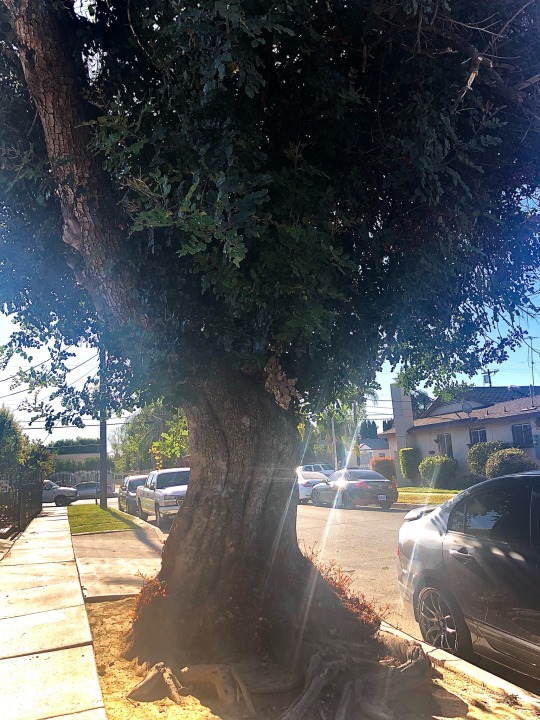

🌲🌳🌴🪵🌱🌿☘️🍀 🌲🌳🌴🪵🌱🌿☘️
Day 2.
This is Quercus agrifolia, also known as the California/Coast live oak or holm oak. It is native to the California Floristic Province and grows west of the Sierra Nevada mountain range from Mendocino County, California, south to northern Baja California in Mexico.
It is classified as a red oak and can live for over 1000 years. Again I could be wrong but the trunk of this tree is what leads me to believe it is a California live oak, mainly because it is highly contorted, massive and gnarled. Gnarled means it is twisted and strangely shaped because it is old.
In the 18th century, Spaniards in the San Fernando Valley (where I found this tree) used the wood for charcoal to fire kilns in making adobe (mud bricks). Later this form of charcoal would be utilized in baking, gunpowder and in the electric power industries.
The Coast Live Oak is known as Encino/Encina in Spanish and this is what the city of Encino is named after.
The red twig like situation at the base of the tree indicates that the tree may be stressed and is growing suckers. Suckers are stems that steal water and nutrients from the main tree. They are a tree’s attempt at growing more branches, often in response to an injury in which the roots have been damaged. They may also be a sign of age considering trees sucker more as they grow old and decay.
🌲🌳🌴🪵🌱🌿☘️🍀 🌲🌳🌴🪵🌱🌿☘️
6 notes
·
View notes
Text


🦜🦢🦩🕊🦚🦤🦜🦢🦩🕊🦚
Day 28.
Today I researched the Canadian Goose found in Reseda Park; Reseda, CA.
The big, black-necked Canada Goose with its signature white chinstrap mark is a familiar and widespread bird of fields and parks. Thousands of “honkers” migrate north and south each year, filling the sky with long V-formations.
During summer, and increasingly at other times of year, Canada Geese are fairly easy to see, swimming in open water, resting near shore, or grazing on lawns or farm fields. They are often heard flying above, by day or night; if you study their honks you may notice the difference by sound when other species of geese or swans are flying.
In a pattern biologists call “assortative mating,” birds of both sexes tend to choose mates of a similar size. The oldest known wild Canada Goose was a female, and at least 33 years, 3 months old when she was shot in Ontario in 2001.:(
She had been banded in Ohio in 1969.
🦜🦢🦩🕊🦚🦤🦜🦢🦩🕊🦚
5 notes
·
View notes
Text
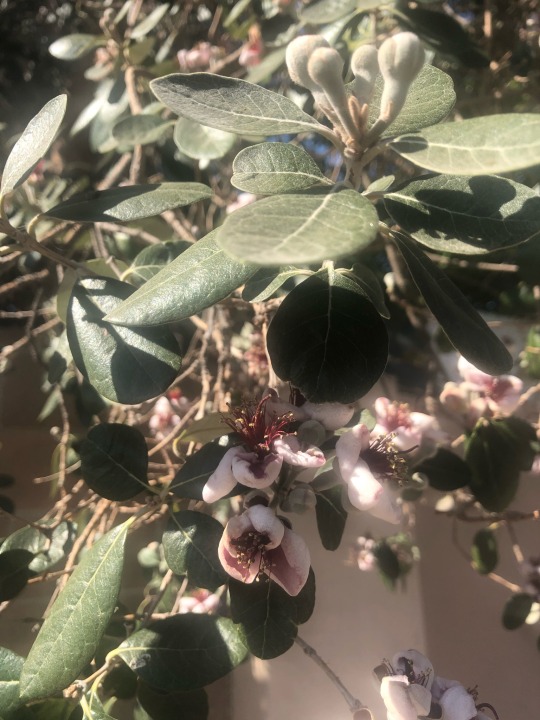

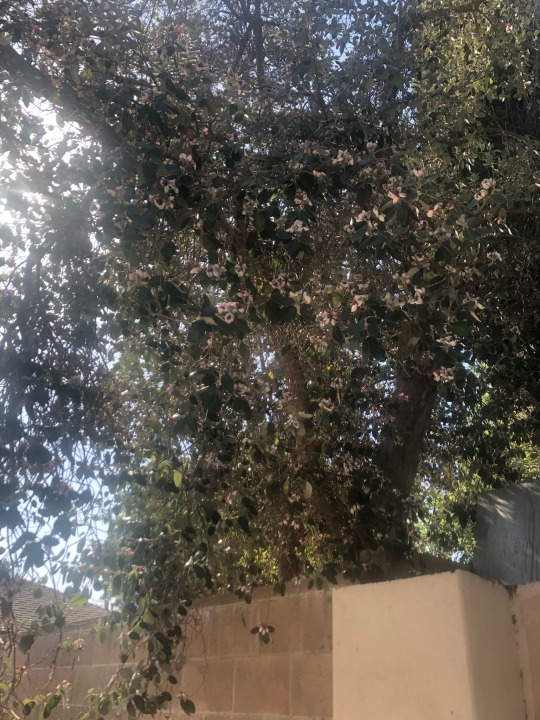
Day 9.
🌺🌸🌼🌻🌺🌸🌼🌻🌺🌸🌼🌻🌺🌸🌼
Today I chose to research the Feijoa sellowiana , A.K.A Pineapple Guava tree, Brazilian Guava, Fig Guava, or Guavasteen. (Despite not being a true guava.)
It is a gray-green evergreen shrub or tree (depending on pruning) from the Myrtaceae family. It produces small, tasty fruit in late summer and early fall. The plants can be pruned to form a hedge or a small tree and will withstand several degrees below freezing. It is native to South America, particularly Brazil and Uruguay, Paraguay, Argentina, and Colombia.
The plant is not used nor is it commonly available in the eastern U.S. This one I found in Southern California. It’s inside someone’s backyard so I wasn’t able to get a good look at the trunk.
It blooms in the late spring/early summer.
The fruit, known as feijoa, matures in autumn, is green, ellipsoid, and about the size of a chicken egg. It has a sweet, aromatic flavour, which tastes like pineapple, apple, and mint. The flesh is juicy and is divided into a clear, gelatinous seed pulp and a firmer, slightly granular, opaque flesh nearer the skin.[7] The fruit falls to the ground when ripe and at its fullest flavour, but it may be picked from the tree prior to falling to prevent bruising. The fruit pulp resembles the closely related guava, having a gritty texture. The feijoa pulp is used in some natural cosmetic products as an exfoliant. Feijoa fruit has a distinctive, potent smell that resembles that of a fine perfume. The aroma is due to the ester methyl benzoate and related compounds that exist in the fruit. Some are self fertile while others require pollination.
As for the floral aspect, it contains fleshy white flower petals with showy red accents contrasting nicely with the gray-green foliage.
🌺🌸🌼🌻🌺🌸🌼🌻🌺🌸🌼🌻🌺🌸🌼
#NaturallyGabakins#Feijoa Sellowiana#Feijoa#Pineapple Guava Tree#Brazilian Guava#Fig Guava#Guavasteen#Myrtaceae#Fruit#Flower#Tree#Nature#Beautiful
4 notes
·
View notes
Text



🌺🌸🌼🌻🌺🌸🌼🌻🌺🌸🌼🌻🌺🌸
Day 20.
Today I researched Piper Auritum, also know as yerba santa, hierba santa, Mexican pepperleaf, acuyo, tlanepa, anisillo, root beer plant, Vera Cruz pepper and sacred pepper, is an aromatic herb with a heart-shaped, velvety leaf which grows in tropic Mesoamerica.
The leaves can reach up to 30 centimeters (12 in) or more in size. The complex flavor of hoja santa is not so easily described; it has been compared to eucalyptus, licorice, sassafras, anise, nutmeg, mint, tarragon, and black pepper. The flavor is stronger in the young stems and veins.
It is native to the Americas, from northern South America to Mexico, and is also cultivated in southeast Florida and California.
It is often used in Mexican cuisine in tamales, fish or meat wrapped in its fragrant leaves for cooking, and as an essential ingredient in mole verde, a green sauce originally from the Oaxaca region of Mexico. It is also used to flavor eggs and soups like pozole. In Central Mexico, it is used to flavor chocolate drinks. In southeastern Mexico, a green liquor called verdín is made from hoja santa. It is also used for tea. In some regions of Mexico, goat cheese is wrapped in hoja santa leaves and imbued with its flavor. While typically used fresh, it is also used dried, although the drying process removes much of the flavor and makes the leaf too brittle to be used as a wrapper.
🌺🌸🌼🌻🌺🌸🌼🌻🌺🌸🌼🌻🌺🌸
#Piper Auritum#Hoja santa#Hierba santa#Mexican pepperleaf#Acuyo#Tlanepa#Anisillo#Root beer plant#Vera Cruz Pepper#Sacred Pepper#flower#flowers#garden#beautiful#nature#naturallygabakins
2 notes
·
View notes
Text
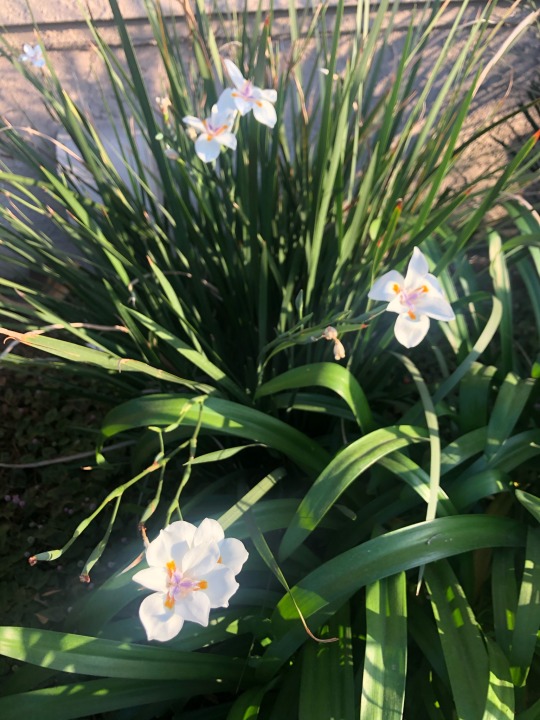
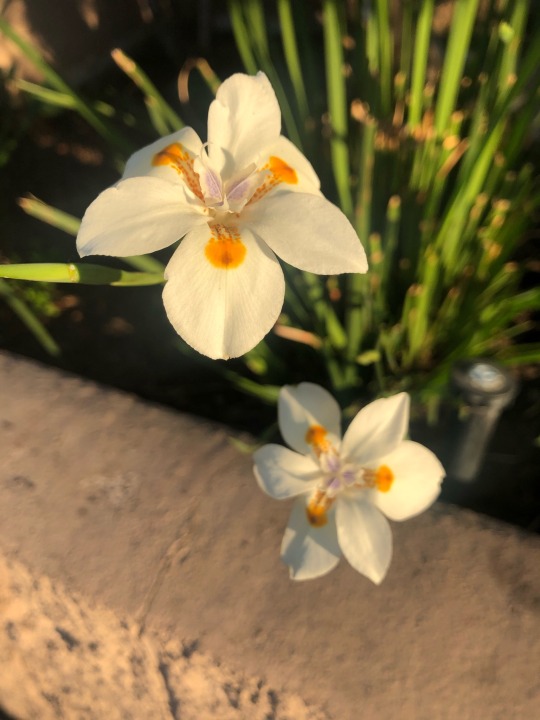
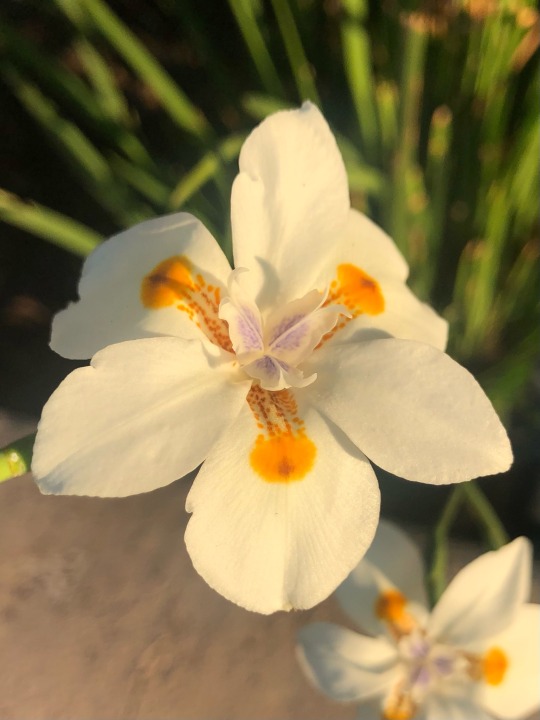
🌺🌸🌼🌻🌺🌸🌼🌻🌺🌸🌼🌻🌺🌸
Day 18.
Today I researched wood iris (Dietes iridioides). Found by neighboring apartments here in SoCal.
Dietes is a genus of rhizomatous plants of the family Iridaceae, first described as a genus in 1866. Common names include wood iris, fortnight lily, African iris, Japanese iris and butterfly iris, each of which may be used differently in different regions for one or more of the six species within the genus.
Most species are native to southern and central Africa, with one (Dietes robinsoniana) native to Lord Howe Island off the coast of Australia. A few species have become naturalized in other parts of the world.
The genus name is derived from the Greek words di-, meaning "two", and etes, meaning "affinities".
🌺🌸🌼🌻🌺🌸🌼🌻🌺🌸🌼🌻🌺🌸
#Dietes iridioides#Wood Iris#Fortnight Lily#African Iris#Japanese Iris#Butterfly Iris#flower#flowers#garden#beautiful#nature#naturallygabakins
4 notes
·
View notes
Text
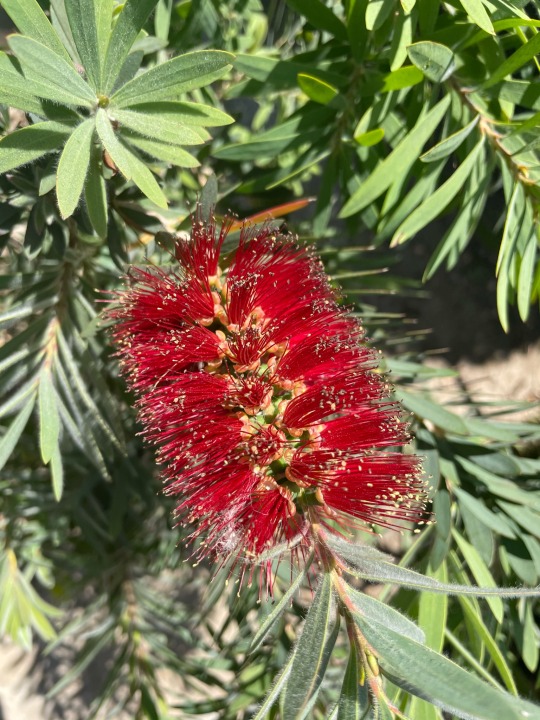

🌺🌸🌼🌻🌺🌸🌼🌻🌺🌸🌼🌻🌺🌸
Day 15.
Today I researched Melaleuca viminalis.
This one was found growing in a residential area of SoCal.
It is commonly known as weeping bottlebrush, or creek bottlebrush. It’s a plant in the myrtle family, Myrtaceae and is endemic to New South Wales, Queensland and Western Australia.
It is a multi-trunked, large shrub or tree with hard bark, often pendulous foliage and large numbers of bright red bottlebrush flowers in spring and summer. It is possibly the most commonly cultivated melaleuca in gardens and its cultivars are often grown in many countries.
Melaleuca viminalis provides food for nectivores. Its adaptations to survive strong currents during flood events allow it to slow the flow of floodwater and reduce erosion, thereby improving the water quality in streams and rivers. The matted roots of this species also strengthen the soil of riverbanks, further reducing the potential for erosion.
🌺🌸🌼🌻🌺🌸🌼🌻🌺🌸🌼🌻🌺🌸
#Melaleuca#Melaleuca Viminalis#Melaleuca Gardens#Bottlebrush#Myrtaceae#Flower#Flowers#Garden#Nature#NaturallyGabakins
4 notes
·
View notes
Text


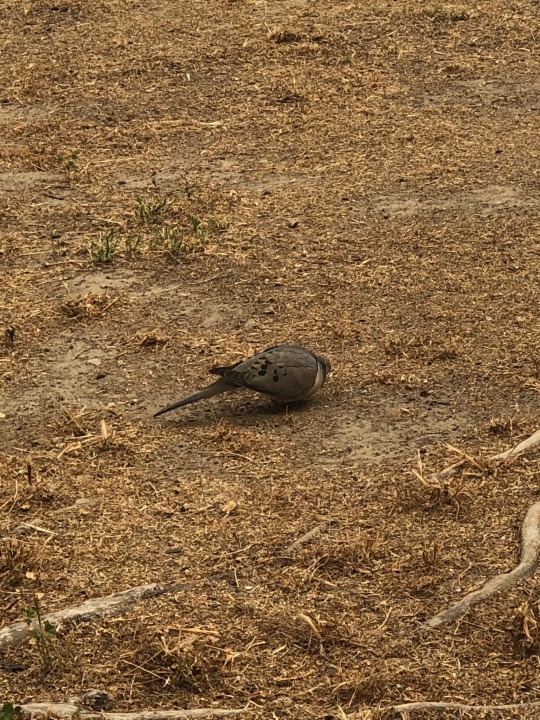
🦜🦢🦩🕊🦚🦤🦜🦢🦩🕊🦚🦜🦢🦩🕊
Day 12.
Today I researched the Mourning Dove.
These guys have been driving my grandma crazy because they’ve formed a nest on the side of the house. From her room she can hear them clearly and she hates it. Lol. But I digress.
The mourning dove (Zenaida macroura) is a member of the dove family, Columbidae. It is also known as the American mourning dove, the rain dove, and colloquially as the turtle dove, and was once known as the Carolina pigeon and Carolina turtledove. It is one of the most abundant and widespread of all North American birds. It is also a leading gamebird, with more than 20 million birds (up to 70 million in some years) shot annually in the U.S., both for sport and for meat. :(
The wings make an unusual whistling sound upon take-off and landing, a form of sonation. The bird is a strong flier, capable of speeds up to 88 km/h (55 mph). It is the national bird of the British Virgin Islands.
Mourning doves are light grey and brown and generally muted in color. Males and females are similar in appearance. The species is generally monogamous, with two squabs (young) per brood. Both parents incubate and care for the young. Mourning doves eat almost exclusively seeds, but the young are fed crop milk by their parents.
The mourning dove is now placed in the genus Zenaida, introduced in 1838 by the French naturalist Charles Lucien Bonaparte. The genus name commemorates Zénaïde Laetitia Julie Bonaparte, wife of the French ornithologist Charles Lucien Bonaparte and niece of Napoleon Bonaparte. The specific epithet is from the Ancient Greek makros meaning "long" and -ouros meaning "-tailed".
The plumage is generally light gray-brown and lighter and pinkish below. The wings have black spotting, and the outer tail feathers are white, contrasting with the black inners. Below the eye is a distinctive crescent-shaped area of dark feathers. The eyes are dark, with light skin surrounding them. The adult male has bright purple-pink patches on the neck sides, with light pink coloring reaching the breast. The crown of the adult male is a distinctly bluish-grey color. Females are similar in appearance, but with more brown coloring overall and a little smaller than the male. The iridescent feather patches on the neck above the shoulders are nearly absent, but can be quite vivid on males. Juvenile birds have a scaly appearance, and are generally darker.
Courtship begins with a noisy flight by the male, followed by a graceful, circular glide with outstretched wings and head down. After landing, the male will approach the female with a puffed-out breast, bobbing head, and loud calls. Mated pairs will often preen each other's feathers. The male then leads the female to potential nest sites, and the female will choose one. The female dove builds the nest. The male will fly about, gather material, and bring it to her. The male will stand on the female's back and give the material to the female, who then builds it into the nest.
The eastern mourning dove is Wisconsin's official symbol of peace. The bird is also Michigan's state bird of peace.
🦜🦢🦩🕊🦚🦤🦜🦢🦩🕊🦚🦜🦢🦩🕊
#Mourning Dove#Zenaida Macroura#Columbidae#American Mourning Dove#Rain Dove#Turtle Dove#NaturallyGabakins
2 notes
·
View notes
Text



🌺🌸🌼🌻🌺🌸🌼🌻🌺🌸🌼🌻🌺🌸
Day 11.
Today I researched Wax Begonias.
These were found by neighboring apartments in my area.
They are also called Bedding Begonia, and Wax Leaf Begonia. They were previously known as Begonia semperflorens-cultorum, and Begonia x tuberhybrida.
They belong to the Begoniaceae (begonia) family, the name of which honors Michael Begon (1638-1710), Governor of French Canada, and includes about 1500 different species and hundreds of hybrids.
It is a compact, mounded, succulent, and fibrous-rooted plant with fleshy stems and green to bronze leaves. Loose clusters of cymes in leaf axils, single or double and in various colors, bloom from spring to frost. It is susceptible to mealy bugs and thrips, rot, and fungal diseases.
This one in particular is called “party pink” and consists of pink flowers with bronze leaves.
🌺🌸🌼🌻🌺🌸🌼🌻🌺🌸🌼🌻🌺🌸
2 notes
·
View notes
Text

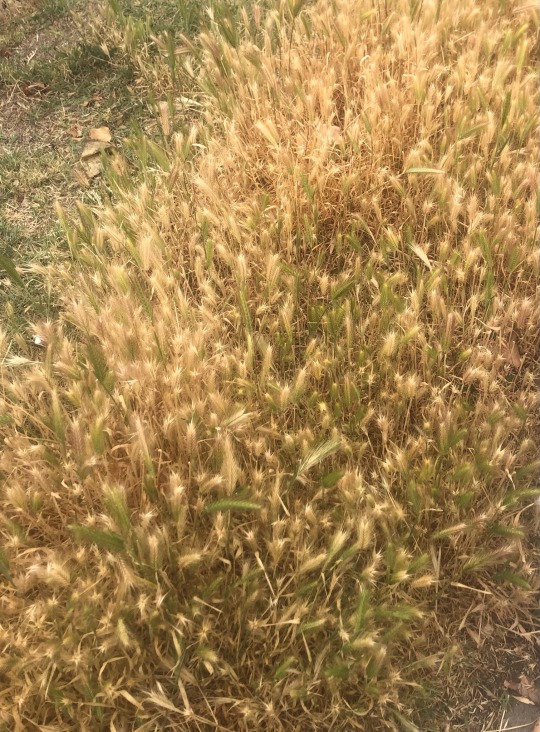
🍂🌾🪨🍂🌾🪨🍂🌾🪨🍂🌾🪨🍂🌾🪨
Day 10.
Today I chose to research hare barley; A.K.A foxtail, wild barley, wall barley, and smooth barley.
Scientific names: Hordeum murinum,
Hordeum leporinum, Hordeum glaucum Steud., Hordeum stebbinsii Covas.
It is an annual grass with long awns (family Poaceae). It may have arrived to California with Spanish settlers and is more common than Mediterranean barley in disturbed, dry upland areas.
They are yellow and bloom in the mid spring. Leaves are medium green and deciduous. It tends to grow in meadows, pastures and streambanks, at elevations from 0-8500 feet.
The reason I personally don’t like these is because it’s a serious hazard for field dogs, or any dogs in the field. These structures have sharp points at one end, and microscopic barbs, so that they easily move in the direction of the point, but not the other way. They "work in", but they don't "work out". They can become imbedded in the hair, especially the paws and ears, and in nostrils and even eyes. As they work their way in, they cause infection, and if not treated can sometimes be fatal.
🍂🌾🪨🍂🌾🪨🍂🌾🪨🍂🌾🪨🍂🌾🪨
#NaturallyGabakins#Hare Barley#Foxtail#Wild Barley#Wall Barley#Smooth Barley#Hordeum Murinum#Grass#Flowers#Garden
2 notes
·
View notes
Text

🌺🌸🌼🌻🌺🌸🌼🌻🌺🌸🌼🌻🌺🌸🌼
Day 8.
Today I chose to research the Lilac/White/Yellow Chrysanthemums that my husband brought home.
These were hard to figure out because there are so many varieties of Chrysanthemums, I’m surprised there aren’t different specifications for them considering how different they all look.
These are called mums or chrysanths, they are flowering plants of the genus Chrysanthemum in the family Asteraceae. They are native to East Asia and northeastern Europe.
The name "chrysanthemum" is derived from the Ancient Greek: χρυσός chrysos (gold) and Ancient Greek: ἄνθεμον anthemon (flower).
Genera now separated from Chrysanthemum include Argyranthemum, Glebionis, Leucanthemopsis, Leucanthemum, Rhodanthemum, and Tanacetum. I wouldn’t be surprised if these fell into any of those categories, they are very similar.
Chrysanthemums are divided into two basic groups, garden hardy and exhibition. Garden hardy mums are new perennials capable of wintering in most northern latitudes. Exhibition varieties are not usually as sturdy. Garden hardies are defined by their ability to produce an abundance of small blooms with little if any mechanical assistance, such as staking, and withstanding wind and rain. Exhibition varieties, though, require staking, overwintering in a relatively dry, cool environment, and sometimes the addition of night lights. I believe these to be garden hardy.
In some countries of Europe (e.g., France, Belgium, Italy, Spain, Poland, Hungary, Croatia), incurve chrysanthemums symbolize death and are used only for funerals or on graves, while other types carry no such symbolism; similarly, in China, Japan, and Korea of East Asia, white chrysanthemums symbolize adversity, lamentation, and/or grief. In some other countries, they represent honesty. In the United States, the flower is usually regarded as positive and cheerful, with New Orleans as a notable exception. In the Victorian language of flowers, the chrysanthemum had several meanings. The Chinese chrysanthemum meant cheerfulness, whereas the red chrysanthemum stood for "I Love", while the yellow chrysanthemum symbolized slighted love. The chrysanthemum is also the flower of November.
🌺🌸🌼🌻🌺🌸🌼🌻🌺🌸🌼🌻🌺🌸🌼
#NaturallyGabakins#Chrysanthemums#Chrysanths#Mum#Asteraceae#Daisy#Flower#Flowers#Garden#Nature#Cute#Beautiful
2 notes
·
View notes
Text

“In the beginning God created the heavens and the earth.”
-Genesis 1:1
🤍
#Christian#Christian Coloring Book#Coloring#Coloring Book#Faith#Inspiration#Worship#NaturallyGabakins
2 notes
·
View notes
Text
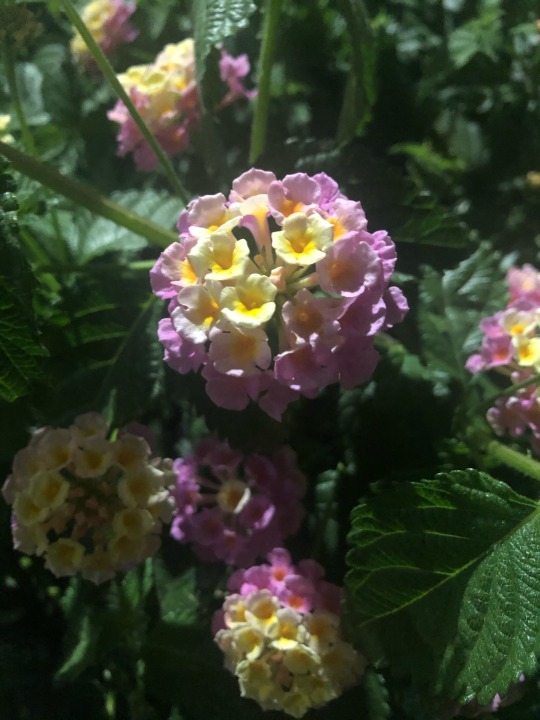
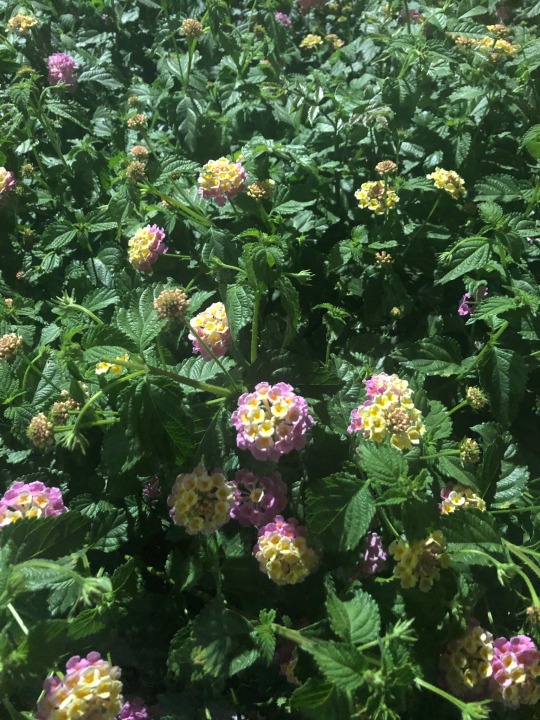
🌺🌸🌼🌻🌺🌸🌼🌻🌺🌸🌼🌻🌺🌸🌼
Day 6.
Lantana camara (common lantana) is a species of flowering plant within the verbena family (Verbenaceae). It is native to Central and South America. It is known as L. camara, Spanish flag, big-sage (Malaysia), wild-sage, red-sage, white-sage (Caribbean), korsu wiri or korsoe wiwiri (Suriname), tickberry (South Africa), West Indian lantana, umbelanterna, putus in Bengal and Gu Phool in Assam, India.
It spread from its native Central and South America to around 50 countries, where it became an invasive species. It first spread out of the Americas and was brought to Europe by Dutch explorers and cultivated widely, soon it spread further into Asia and Oceania where it established itself as a notorious weed.
L. camara has small tubular shaped flowers, which each have four petals and are arranged in clusters in terminal areas stems. Flowers come in many different colours, including red, yellow, white, pink and orange, which differ depending on location in inflorescences, age, and maturity. The flower has a tutti frutti smell with a peppery undertone. After pollination occurs, the colour of the flowers changes (typically from yellow to orangish, pinkish, or reddish); this is believed to be a signal to pollinators that the pre-change colour contains a reward as well as being sexually viable, thus increasing pollination efficiency.The leaves are broadly ovate, opposite, and simple and have a strong odour when crushed. The fruit of L. camara is a berry-like drupe which turns from green to dark purple when mature. Green unripe fruits are inedible to humans and animals alike. Because of dense patches of hard spikes on their rind, ingestion of them can result in serious damage to the digestive tract.
I’m glad I learned more about this little flower because I had no idea it was toxic and the apartment buildings down my block have a variety of them. I walk my dogs by there often, I know to be more careful now.
🌺🌸🌼🌻🌺🌸🌼🌻🌺🌸🌼🌻🌺🌸🌼
3 notes
·
View notes
Text




🌺🌸🌼🌻🌺🌸🌼🌻🌺🌸🌼🌻🌺🌸🌼
Day 5.
I learned something new today (as I do every day) but this one blew my mind a bit. Lol. I’m not sure why it has taken me 25 years to learn this but here it goes.
Taraxacum officinale is a large genus of flowering plants in the family Asteraceae, which consists of species commonly known as dandelions (French dent-de-lion, meaning 'lion's tooth'). It is native to Eurasia and North America, originally introduced from Europe they were brought to North America on the Mayflower for their medicinal benefits.
They were well known to ancient Egyptians, Greeks and Romans, and are recorded to have been used in traditional Chinese medicine for over a thousand years. The plant was used as food and medicine by Native Americans.
These have very small flowers collected together into a composite flower head and each single flower in a head is called a floret.
The flower head is surrounded by bracts (sometimes mistakenly called sepals) in two series. The inner bracts are erect until the seeds mature, then flex downward to allow the seeds to disperse. The outer bracts are often reflexed downward.
So here’s what blew my mind. After flowering is finished, the dandelion flower head dries out for a day or two. The dried petals and stamens drop off, the bracts reflex (curve backwards), and the parachute ball opens into a full sphere. When development is complete, the mature seeds are attached to white, fluffy "parachutes" which easily detach from the seedhead and glide by wind, dispersing.
Never in my life would I have guessed this little yellow flower could transform into a little ball of fluff. 💛
🌺🌸🌼🌻🌺🌸🌼🌻🌺🌸🌼🌻🌺🌸🌼
#NaturallyGabakins#Taraxacum#Taraxacum officinale#Asteraceae#Dandelion#Flower#Flowers#Garden#Gardening#Nature
2 notes
·
View notes
Text



🌺🌸🌼🌻🌺🌸🌼🌻🌺🌸🌼🌻🌺🌸
Day 16.
Today I researched Birds of Paradise or Strelitzia reginae, also known as crane flower.
It is native to South Africa and derives its name from the unusual flowers, which resemble brightly colored birds in flight. The plant needs warm temperatures and plenty of sunshine to produce the characteristic blooms.
In South Africa it is featured on the reverse of the 50 cent coin.
Interestingly enough, it is the floral emblem of the City of Los Angeles.
They are pollinated by sunbirds, which use the spathe as a perch when visiting the flowers. The weight of the bird when standing on the spathe opens it to release the pollen onto the bird's feet, which is then deposited on the next flower it visits. Strelitzia lack natural insect pollinators; in areas without sunbirds, plants in this genus generally need hand pollination in order to successfully set seed.
🌺🌸🌼🌻🌺🌸🌼🌻🌺🌸🌼🌻🌺🌸
#Bird of Paradise#Flower#Flowers#Strelitzia Reginae#Crane Flower#Garden#Beautiful#Nature#NaturallyGabakins
1 note
·
View note
Text

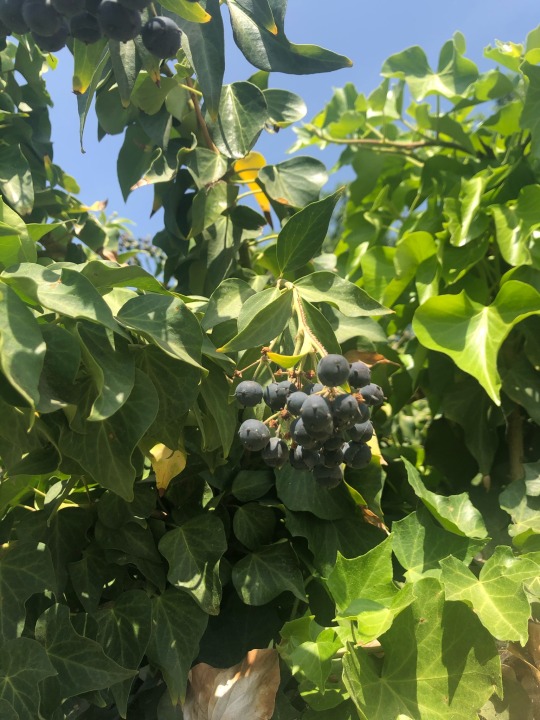

🫐🌿🌱🍃🫐🌿🌱🍃🫐🌿🌱🍃
Day 13.
Today I researched Ivy.
It’s also known as Hedera helix, the common ivy, English ivy, European ivy, or just ivy.
It’s a species of flowering plant of the ivy genus in the family Araliaceae, native to most of Europe and western Asia. A rampant, clinging evergreen vine, it is a familiar sight in gardens, waste spaces, and wild areas, where it grows on walls, fences, tree trunks, etc. across its native and introduced habitats.
The genus name Hedera is the Classical Latin word for 'ivy', which is cognate with Greek χανδάνω (khandánō) 'to get, grasp', both deriving ultimately from Proto-Indo-European *gʰed- 'to seize, grasp, take'. The specific epithet helix derives from Ancient Greek ἕλιξ (elix), 'helix', and from the Latin helicem, 'spiral', first used around 1600.The binomial in its entirety thus has the meaning "the clinging plant that coils in spirals (helices)".
The modern English ivy derives from Middle English ivi, from Old English īfiġ, deriving in turn from Proto-Germanic *ibahs. The meaning is uncertain, but the word may be cognate with the Ancient Greek ἴφυον (íphuon), referring to not Hedera helix, but the unrelated English lavender, or Lavandula angustifolia.
Ivy berries are somewhat poisonous to humans, but ivy extracts are part of current cough medicines. In the past, the leaves and berries were taken orally as an expectorant to treat cough and bronchitis. In 1597, the British herbalist John Gerard recommended water infused with ivy leaves as a wash for sore or watering eyes. The leaves can cause severe contact dermatitis in some people.
People who have this allergy (strictly a type IV hypersensitivity) are also likely to react to carrots and other members of the Apiaceae as they contain the same allergen, falcarinol. Owing to the large number of saponins in the leaves and fruits of H. helix, it is mildly poisonous to animals like rabbits and can lead to anemia.
Ivy should not be planted or encouraged in areas where it is invasive. Where it is established, it is very difficult to control or eradicate. In the absence of active and ongoing measures to control its growth, it tends to crowd out all other plants, including shrubs and trees.
I found these down my block by a law firm. I realized after researching that it truly is growing rapidly, a 40ft wall is completely covered with it and it’s going up the trees as well. I wonder if they’re having a hard time keeping it under control or if they don’t mind it at all.
🫐🌿🌱🍃🫐🌿🌱🍃🫐🌿🌱🍃
#Ivy#hedera helix#Common Ivy#English Ivy#European Ivy#Araliaceae#NaturallyGabakins#Garden#Flower#Berry#Beautiful#Cute#Nature#Natural#flowers
1 note
·
View note